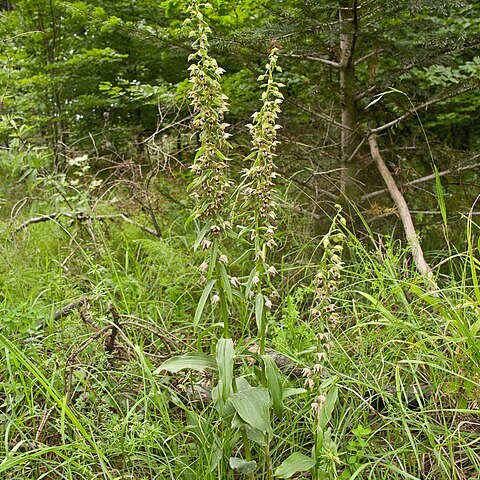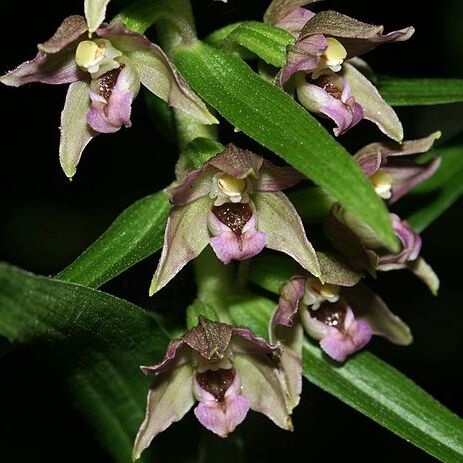Terrestrial, occasionally saprophytic herbs with horizontal or vertical, very short rhizomes, numerous fleshy roots and simple, erect, leafy stems. Leaves ovate or lanceolate, plicate, occasionally very small. Flowers in ± secund racemes, rather inconspicuous, spreading or pendulous, shortly pedicelled. Tepals spreading or remaining closed, dull reddish or greenish. Sepals free, subequal. Petals scarcely smaller than sepals. Lip usually in 2 parts articulated by a narrow joint or fold (mesochile); the basal part (hypochile) forms a nectar-containing cup often with a pair of basal bosses; the apical part (epichile) forms a ± cordate or triangular downwardly directed terminal lobe; spur absent. Column short, flat or concave in front with a shallow cup at apex; anther free, hinged at the back of the summit of the column, behind the stigma and rostellum, ovate, slightly convex, 2-celled; pollinia 2, tapering towards their apices near which they are attached to the rostellum, each ± divided longitudinally into halves; caudicles absent; pollen grains forming friable masses loosely bound by fine threads; stigma prominent, broad; rostellum placed centrally above the stigma, large, globular, persistent, evanescent or absent. Capsule oblong, spreading or pendulous.
Herbs perennial, terrestrial, glabrous or puberulent to glabrate. Roots from short rhizome, fibrous. Stems leafy. Leaves several, alternate, sheathing, plicate, grading into floral bracts. Inflorescences terminal racemes; floral bracts leaflike, often exceeding flowers. Flowers few to many, resupinate, pedicellate; perianth free, spreading or loosely connivent, subequal; sepals ovate to ovate-lanceolate, concave; petals often shorter than sepals; lip sessile at base of column, fleshy, divided into 2 parts by central constriction, proximal part (hypochile) deeply concave to saccate, distal part (epichile) triangular to oblanceolate, with pair of calli near base; column curved over lip, broadened distally, short; anther terminal, sessile; pollinia 4, mealy. Fruits capsules, pendent to spreading, obovoid to ellipsoid.
Sep and lateral pet similar; lip strongly saccate in the basal half, the terminal lobe broadly ovate, not hinged to the basal part, crested at its base with 2 evident swellings; column very short and broad, the large sessile anther hinged to its back below the middle and somewhat projecting; pollinia 4; rhizomatous or stoloniferous plants with numerous alternate lvs and a terminal raceme. 25, N. Hemis.
Column short, flat or concave in front, with a shallow cup at the apex; anther free, 2-celled, hinged at the back of the column apex, behind the stigma and rostellum; pollinia 2, attached near the rostellum apex, each longitudinally divided, caudicles absent; pollen grains in friable masses loosely bound by fine threads.
Lip with no spur, but with the hypochile forming a nectar-containing cup; hypochile articulated to the epichile by a narrow joint.
Terrestrial herb, occasionally saprophytic, with very short rhizomes, numerous fleshy roots and simple erect leafy stems.
Inflorescence racemose; flowers usually dull reddish or greenish, pedicelled.
Stigma broad, with the large, globular rostellum placed centrally above it.
Leaves ovate or lanceolate, plicate.
Sepals and petals free.


